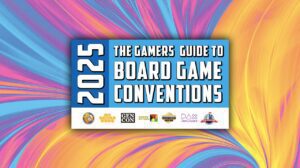This is the third volume of Perfected Game Mechanics (Volume 1, Volume 2), a series exploring games where, be they wonderful, amazing, inspiring, or even flawed in some ways, managed to utilize one particular mechanic with sheer perfection. That one mechanic is not going to be improved upon; there is nowhere “up” to go.
Note: the images representing the mechanics are from BoardGameGeek.
Highest-Lowest Scoring

Definition: each player has scores in multiple areas or categories. The lowest of these scores is their final score. The highest final score wins.
Ingenious
BoardGameGeek lists only 268 games that use this mechanic. Even with so few games, this one has some great games vying for the top spot, such as Tigris & Euphrates, Gans Schön Clever, Between Two Cities, and Fields of Arle. There are literally a dozen games that could be said to have perfected this mechanic. For my money, the top prize goes to Ingenious.
Ingenious uses hexagonal dominoes with any of six colored shapes on either end, played onto a board consisting of rings of hexes. Players have six of these in their rack. When placed, each side of the domino scores based on the number of like-colored shapes extending off in each of the five scoring directions (i.e., every direction except the one attached to the domino). The score added to the color of that shape (e.g., red stars score the red peg, purple rings score the purple peg, and so on). A player who gets a peg to a score of 18 gets to play an additional domino that turn. If that results in another peg scoring 18, they get to play another domino, and so on. Once all plays have been made for a turn, the player draws back up to six dominos.
The simplicity of the rules and the highest-lowest scoring system barely scratch the surface of this game’s genius. Consider, for example, the game’s scaling: the outermost ring of the board is only used in 4 player games, and the ring just inside that one is only used in 3-4 player games. This provides a perfect balance in the scoring system for any player count. There is even a well-thought-out, and fun, solo mode.
Perhaps it is the fact that this is an abstract that pushes it over the top. Perhaps it is the utter simplicity of the rules. Both of these factors ensure that nothing clouds the view. Beauty and subtlety come through as players balance their efforts across all six colors while focusing on one color just long enough to score 18 points for the extra play.
This is highest-lowest scoring perfection.
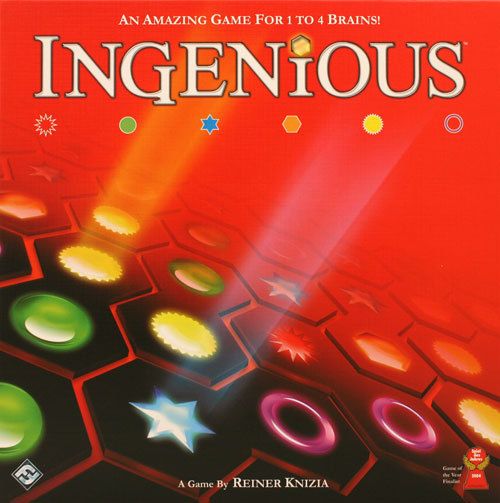
Impulse Movement
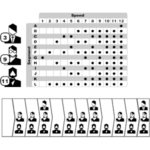
Definition: movement is broken into several sub-steps, called impulses. Based on a unit’s speed, it will advance a portion of its movement allotment on specific impulses.
Star Fleet Battles
Back in the day (as they say), impulse movement made a lot of sense. In games like…
- Car Wars, where cars can easily be doing more than 100 miles per hour and where movement is 1 inch per 10 miles per hour, the idea of moving a vehicle 10 inches at a go makes little sense. Breaking that down into 10 impulses where cars are generally moving a maximum of 1 inch per impulse makes things more manageable and allows for the action to take place in the middle of a game round, when the vehicles are in optimum position.
- Champions, where super-heroic characters can have super-speed, allowing them multiple actions in a single game round, having them all happen at once (with no ability for an opponent to act between them) can be frustrating for the non-speedster. So breaking things into 12 impulses, where characters take their actions at proportionate points in the round, allows for a better representation of the action.
- Any of the varied aircraft and space combat games, where the same issues described in Car Wars (above) are amplified by extreme speeds.
That last point is an important one: extreme speeds create a need to break movement down into manageable chunks. And nothing expresses this need, or handles this system, quite like Star Fleet Battles.
This game, nearly as old as the franchise it is describing, takes the ships of Star Trek and deals with their relative combat speeds in multiples of the speed of light: 1 hex per turn = light speed, and the maximum combat speed in the game is 32 hexes per turn (e.g., in the parlance of the game, somewhere between Warp Factor 3 and Warp Factor 4).
Star Fleet Battles is not a game for those who shy away from math. Every turn, each ship’s power output is calculated (by subtracting any power lost from damage the previous round), then allocated to various systems, from life support, to shielding, to weapons, to movement. In the advanced rules, it might be necessary to allocate power in 1/8th units or smaller. Once that is complete, all players announce the speeds at which their ships are moving, and the 32-sub steps of the turn begin with no unit moving more than one hex per impulse.
Yes, it is a lot of bookkeeping. Yes, if you are playing large fleet actions, this can seem tedious to the uninitiated. But, if this is your groove and you want to take the time needed to delve into this universe, it is an amazingly exciting and tense game with Federation, Klingon, Romulan, and other alien species battling it out for supremacy of the final frontier!
This is impulse movement perfection.
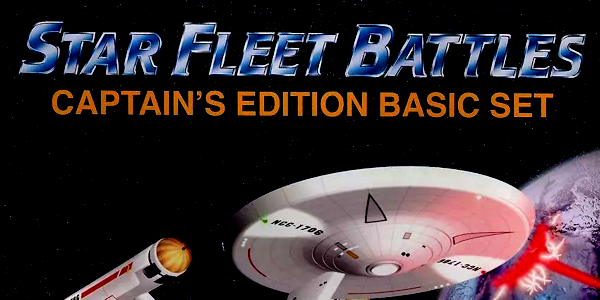
Campaign / Legacy Game

Note: the Legacy and Campaign game mechanics are usually separate from one another. They are so interlinked that we will be treating them as the same thing.
Definition: each session alters an aspect of the game that impacts all later plays. This can be a campaign, where new information is revealed with each session, or it can be something that simply creates new issues/opportunities in later sessions.
Pandemic Legacy (Season 1)
The Legacy Game was given to us by Rob Daviau, when he created Risk Legacy. I have heard at least five different stories about how this mechanism was conceived, the most believable (to me) was the idea of playing a second game of Clue, wondering why people keep showing up to this house when someone is murdered every time the dinner bell rings. However the idea was sparked, it has had a definite impact on the board game industry.
In order to truly work, both campaign and legacy games need to assign true meaning to the changes occurring as a result of a game session. Failure to do so results in something less than satisfying. In some, there is an ongoing story that unfolds; in others, it is just that the world is not the same in the next game for one reason or another. It has been used to good effect in games like Charterstone, Ticket to Ride Legacy, and (of course) Gloomhaven. It has fallen flat in games like Machi Koro Legacy where every change was transient, had nothing to lead into it, had nothing to expect as a result, and all managed to feel like an afterthought. In my opinion, the best use so far is Pandemic Legacy: Season 1.
Note: no spoilers are included in this article.
Pandemic was already one of the best cooperative games out there. The mechanics involved were such that adding legacy elements was not difficult—none of the elements in the game felt like they were shoe-horned in, everything seemed like an organic extension of the original game. Additionally, the legacy elements were meaningful not only to game-play in later sessions, but also to the interesting and ever evolving storyline that unfolded after each session. The games within the campaign kept getting more and more difficult to control despite the fact that you were acquiring new tools to help you. In the end, no matter if you win or lose the campaign, the amount of teamwork-inspired memories this game will generate will make you sad the campaign came to an end. That is a lasting testament to the power of a good campaign / legacy game.
This is campaign / legacy perfection.

Once-Per-Game Abilities

Definition: the game includes special abilities that are only able to be used once in a session. These can be abilities tied to set up, or acquired later in the game.
Empyreal: Spells and Steam
As stated in the definition above, there are a few ways to divvy out once-per-game abilities. Similar to variable player powers, these could be a part of a faction or race and determined during set up (e.g., some of the abilities in King of Tokyo’s Power Up! expansion). Perhaps they could be randomly distributed and kept secret until they are used. Sometimes they are more of a joke than anything serious (e.g., the Feather promo for Castle Panic). The best once-per-game powers are those that can be acquired within the game, like the surveyors in Empyreal: Spells and Steam.
There is a lot to love in Empyreal. From the unique focus of each company, to the individual powers of the company captains (where each company has a choice of leader, or can work with one of the free-agents), to the specialists that can be hired. And herein lies the beauty of this game’s implementation of the once-per-game ability: there are three types of specialist, each focusing on a different area of the game. There are the engineers and the station masters who have cool abilities that can be used multiple times through the game. And there are the surveyors who have insane abilities that can be used only once.
At the start of the game, a random selection of these specialists (one plus the number of players, each) are drawn and placed face-down near the game board. Nobody knows who is in there until it comes time to hire one. When you do, you look at a stack and see who is available and select one. Only then, and when you place the specialist on your player board, does anyone know who is available for this game. And when the specialist being hired is a surveyor, the other players tend to pay close attention to what this individual is capable of. Honestly, any one of these specialists could be seen as game-breaking in isolation. With each player having the ability to hire only one, and each having the ability to use their ability only once…
This is once-per-game perfection.

Player Judge

Definition: one of the players is designated the judge and decides the outcome of various actions. This can be a fixed judge, or one that cycles from player to player.
Apples to Apples
One of the unique aspects of games that use the player judge mechanic is the near complete elimination of edge cases. If used correctly, there aren’t any. Consider games like Joking Hazard, Smug Owls, and the like. By using a player judge, the results of a round are clear. There is no ambiguity. The clarity is created by the fact that you are not just playing the game, you are playing the judge.
Apples to Apples is, by far, the most distilled, most basic, and most beautiful implementation of this mechanic. There have been other games that have tried to utilize this mechanic in similar (if not identical) ways. The one that comes closest to matching the genius of Apples is Dixit. The only reason Dixit is not the game chosen for this article is the built-in ambiguity of the artwork (not saying it is a bad thing—it isn’t—but it is there). Apples to Apples has such a simple and elegant setup that it can easily be played with a wide range of ages and backgrounds: take this adjective and select the noun in your hand that you feel the judge will find best represents it.
Other games have attempted to be “edgy” or “humorous” in using this mechanic. A few have even lit a fire in the board game community. But (in my very humble opinion) the edgy factor always reduces down to gutterspeak and the humor always becomes stale over time. If you want edgy and/or humor, Apples to Apples can do those without being forced. And if you have a group that is not leaning that way, Apples to Apples can be good, clean, family fun. It really is that good.
Apples to Apples is one of those games that is almost perfect. It’s only flaw? Someone over at Out of the Box Publishing or one of the other publishers needed to release annual packs of cards that used adjectives and nouns indicative of the previous year (or perhaps a few that covered a previous decade until you caught up with the calendar). Begin with a pack for (say…) the 1920s, then release a new pack covering the next decade periodically until you get to the 2000s or 2020s, at which time you start releasing the annual packs: 2021, then 2022, and so on, with the adjectives and nouns tailored for that period without duplicating anything in the core. This would be amazing. But even without it…
This is player judge perfection.
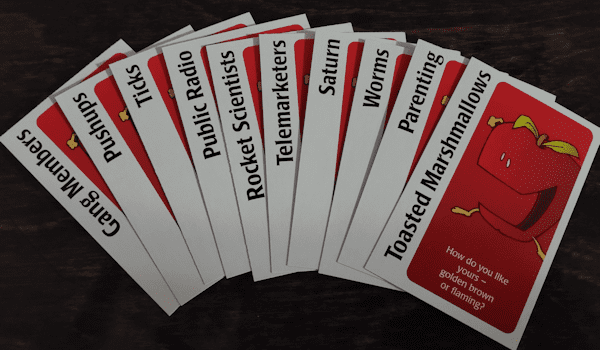
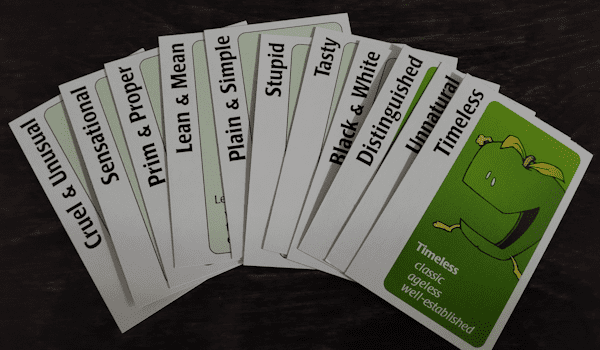
Ratio / Combat Result Table

Definition: common in wargames, the combat strength of the attacker and defender are compared and reduced to a simple fraction. This is indexed on a table where a die roll or card play will determine the outcome.
OGRE
Set the Wayback Machine for 1954. This is the earliest year associated with a game that uses this mechanic listed on BoardgameGeek: Tactics. In 1958, the sequel would be released (Tactics II) as well as the game Gettysburg. This sort of game would be the staple of Avalon Hill’s “Adult Games” collection for many years to come. It is a relatively simple idea: the factions in your game are using equivalent equipment and have relatively stable strengths. So you compare troop strengths and come up with a ratio. Does the attacker outnumber the defender two-to-one? Three-to-two? Three-to-one? More? Use that to inform the die roll (if needed) and consult the combat results chart to see what happened.
Many games have used similar systems. Some of the best include Kingmaker, Advanced Squad Leader, and the like. Some of the worst include such travesties as Hyper Battle, or Campaigns of the Civil War: Vicksburg and Chancellorsville. Using such a system can seem as though it would increase the complexity of a game (or at least induce panic in the math-phobic). But when handled well and with clarity, it can help to reduce the complexity (and potentially calm the math-phobic). Such a case is with Steve Jackson’s Ogre.
Numbers are kept relatively small. The ratios use no obscure values (e.g., three-to-two). The combat results table is easy to use, obvious in its progression, can be memorized in-game, and takes only a few seconds to utilize. Every combat event in the game uses minimal time to resolve, making for a game that is zippy whether your side is a single Ogre Mk. VI cyber tank, or literally dozens of infantry and armored units maneuvering within a post-apocalyptic hellscape.
Could this system be adjusted to not use a combat results table? Perhaps. But nothing done to this system would actually simplify it or speed things up without also resulting in a more generic, less flavorful game. This is a tried-and true system that, in this case, is just what the doctor ordered.
This is ‘ratio / combat results table’ perfection.

Final Thoughts
Six games where each represents perfection in a specific mechanic (IMVHO, YMMV, yadda yadda yadda). Each has flaws, but they are eclipsed by the greatness within. Were I to give each game a full review, none would be rated below four stars. They are great games!
What other games have managed to perfect a mechanic? Meeple Mountain will delve into others in future articles. In the meantime, what games have you played where you noticed a particular mechanic transcending its use elsewhere? Did the rest of the game measure up? Let us know in the comments!









